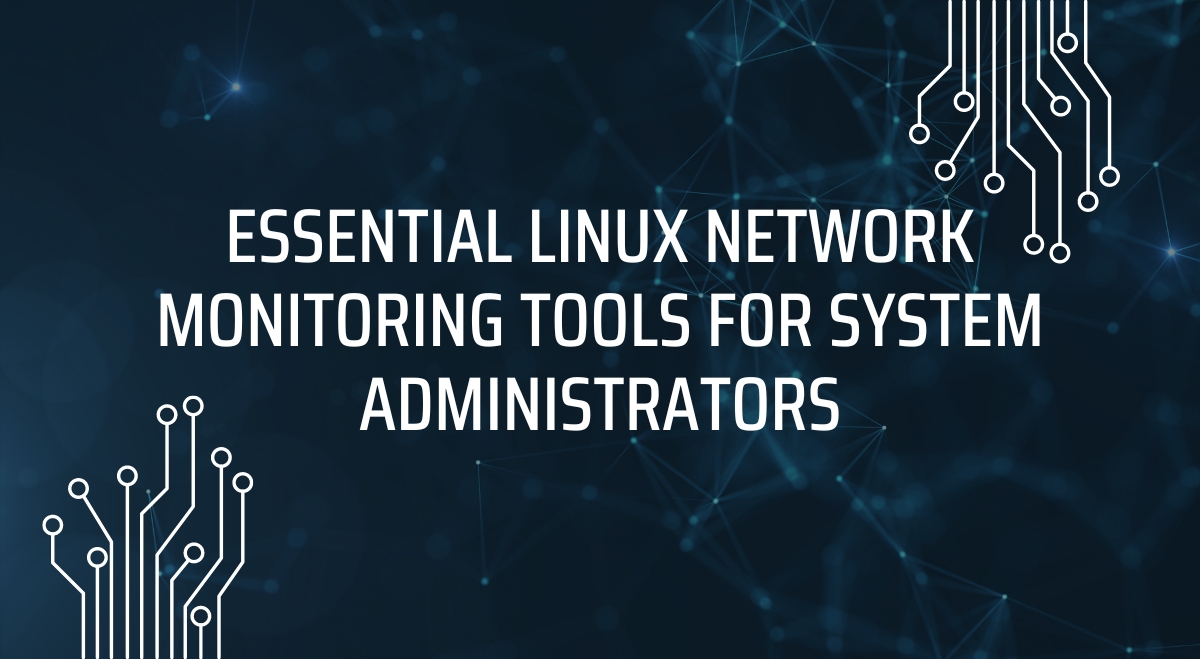Network monitoring is crucial for maintaining the health, performance, and security of Linux systems. As a system administrator, having the right tools at your disposal can make a significant difference in managing your network effectively. This guide will explore various Linux network monitoring tools, both command-line and GUI-based, to help you choose the best options for your needs.
Command-line Network Monitoring Tools in Linux
Nload
Nload is a simple yet powerful tool for real-time monitoring of network traffic. It displays incoming and outgoing traffic as graphs, making it easy to visualize bandwidth usage.
Key features:
- Real-time traffic monitoring
- Graphical representation of bandwidth usage
- Displays the total amount of transferred data
- Shows minimum and maximum network usage
Usage:
sudo nload
Iftop
Iftop measures network traffic on a specific interface and displays a table of current bandwidth usage by host.
Key features:
- Displays bandwidth usage per connection
- Shows host-to-host connections
- Supports filtering to focus on specific traffic
Usage:
sudo iftop
NetHogs
NetHogs stands out by organizing bandwidth usage by individual process, making it easier to identify which applications are consuming the most network resources.
Key features:
- Groups bandwidth by process
- Helps identify causes of sudden traffic spikes
- Doesn’t require a special kernel module
Usage:
sudo nethogs
Iptraf
Iptraf is an interactive IP LAN monitor that provides detailed information about network connections.
Key features:
- Monitors IP traffic passing over network interfaces
- Generates various network statistics
- Supports both IPv4 and IPv6
Usage:
sudo iptraf
Tcpdump
Tcpdump is a powerful packet analyzer that allows you to capture and display TCP/IP and other packets being transmitted or received over a network.
Key features:
- Captures and analyzes network packets
- Supports complex filtering options
- Useful for troubleshooting network issues
Usage:
sudo tcpdump -i eth0
GUI-based Network Monitoring Tools in Linux
Wireshark
Wireshark is a popular network protocol analyzer available in both CLI and GUI versions.
Key features:
- Deep packet inspection
- Supports hundreds of protocols
- Powerful filtering and search capabilities
Nagios
Nagios is a comprehensive monitoring system that can monitor network services, and host resources, and alert you when problems occur.
Key features:
- Monitors network services and host resources
- Provides alerts and notifications
- Supports plugins for extended functionality
Zabbix
Zabbix is an enterprise-class open-source monitoring solution for networks and applications.
Key features:
- Real-time monitoring of thousands of servers, VMs, and network devices
- Flexible notification system
- Powerful reporting and data visualization
Cacti
Cacti is a complete network graphing solution designed to harness the power of RRDTool’s data storage and graphing functionality.
Key features:
- Customizable graph templates
- User-based management and security
- Supports SNMP for data collection
Observium
Observium is an auto-discovering network monitoring platform with support for a wide range of network hardware and operating systems.
Key features:
- Automatic device discovery
- Detailed device performance graphs
- Supports a wide range of network protocols
Specialized Monitoring Tools
Bandwidth Monitoring: Speedometer and Bmon
Speedometer and Bmon are lightweight tools specifically designed for monitoring network bandwidth.
Traffic Analysis: EtherApe and Ntopng
EtherApe provides a graphical network monitor, while Ntopng offers a web-based traffic analysis and flow collection tool.
System Resource Monitoring: Glances and Monitorix
Glances and Monitorix provide comprehensive system monitoring, including network statistics along with other system resources.
Choosing the Right Tool
When selecting a network monitoring tool, consider the following factors:
- Network size and complexity
- Specific monitoring needs (e.g., bandwidth, security, performance)
- Your level of expertise
- Integration with existing systems
- Budget constraints
Compare the features of different tools to find the best fit for your requirements. For small networks, command-line tools might be sufficient, while larger networks may benefit from more comprehensive solutions like Nagios or Zabbix.
Best Practices for Network Monitoring
- Set up alerts and notifications for critical issues
- Regularly benchmark network performance
- Implement security measures to protect monitoring data
- Keep monitoring tools and systems updated
- Document your monitoring setup and procedures
Troubleshooting Common Network Issues
Use these tools to identify and resolve common problems:
- High latency: Use ping and traceroute to identify bottlenecks
- Bandwidth issues: Employ Iftop or NetHogs to find bandwidth-hungry processes
- Packet loss: Analyze with Wireshark or tcpdump
- DNS problems: Troubleshoot with dig or nslookup
Conclusion
Effective network monitoring is essential for maintaining a healthy and efficient Linux infrastructure. By leveraging the right combination of tools, you can gain valuable insights into your network’s performance, quickly identify issues, and ensure optimal operation of your systems.
Remember to choose tools that best fit your specific needs and environment, and don’t hesitate to explore multiple options to create a comprehensive monitoring solution.

